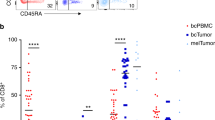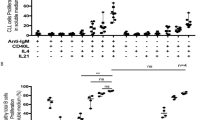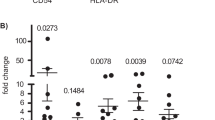Abstract
A conspicuous T cell infiltration is frequently observed in triple-negative and/or basal-like breast cancers. Since the immunological course of breast cancer is explicitly directed by helper T cells, this study aims to determine the influence of basal-like breast cancer (BLBC) cells on CD4+ T cell responses. Co-cultures were established with breast cancer cell lines and CD4+ T cells under stimulatory conditions. Helper T cell activation, proliferation, cytokine secretion, and differentiation were assessed. Protein and mRNA expression of PD-1 ligands were determined on breast cancer cell lines. Blockade assays were performed in order to determine the functional assets of PD-1 ligation. In contrast to luminal breast cancer cells, BLBC cells allowed CD4+ T cell activation, proliferation, and IFN-γ secretion, but only to a certain extent. A substantial population of CD25+CD127low/− regulatory T (Treg) cells was also induced in BLBC co-cultures. In return, IFN-γ stimulated the upregulation of PD-L1 (B7-H1) and/or PD-L2 (B7-DC) inhibitory molecules on the basal-like cells. In prolonged periods of co-culturing, blockade of PD-1 ligands on BLBC cell lines impaired Treg differentiation, restored IL-2 secretion, and increased CD8+ T cell activation. In conclusion, T helper responses were maintained by BLBC cells. On the other hand, IFN-γ secreted from Th1 and other immune cells upregulated the expression of PD-1 ligands on BLBC cells and modulated the immune reactions. Our results indicate the capacity of BLBCs to adapt to IFN-γ-mediated anti-tumor immune responses and to evade immunity via upregulation of PD-1 ligands.





Similar content being viewed by others
Abbreviations
- BLBC:
-
Basal-like breast cancer
- GITR:
-
Glucocorticoid-induced TNFR-related protein
- GM-CSF:
-
Granulocyte macrophage-colony stimulating factor
- ICOS:
-
Inducible T cell costimulator
- IFN:
-
Interferon
- IL:
-
Interleukin
- OD:
-
Optical density
- PD-1:
-
Programmed death-1
- PD-L:
-
Programmed death-ligand
- PMA:
-
Phorbol 12-myristate 13-acetate
- SD:
-
Standard deviation
- Th cell:
-
Helper T cell
- Th1 cell:
-
Type-1 helper T cell
- TNF:
-
Tumor necrosis factor
- Treg cell:
-
Regulatory T cell
References
Zitvogel L, Tesniere A, Kroemer G (2006) Cancer despite immunosurveillance: immunoselection and immunosubversion. Nature Rev Immunol 6(10):715–727
Matkowski R, Gisterek I, Halon A, Lacko A, Szewczyk K, Staszek U, Pudelko M, Szynglarewicz B, Szelachowska J, Zolnierek A et al (2009) The prognostic role of tumor-infiltrating CD4 and CD8 T lymphocytes in breast cancer. Anticancer Res 29(7):2445–2451
Georgiannos SN, Renaut A, Goode AW, Sheaff M (2003) The immunophenotype and activation status of the lymphocytic infiltrate in human breast cancers, the role of the major histocompatibility complex in cell-mediated immune mechanisms, and their association with prognostic indicators. Surgery 134(5):827–834
Rakha EA, Ellis IO (2009) Triple-negative/basal-like breast cancer: review. Pathology 41(1):40–47
Mohammed ZM, Going JJ, Edwards J, Elsberger B, Doughty JC, McMillan DC (2012) The relationship between components of tumour inflammatory cell infiltrate and clinicopathological factors and survival in patients with primary operable invasive ductal breast cancer. Br J Cancer 107(5):864–873
Liu S, Lachapelle J, Leung S, Gao D, Foulkes WD, Nielsen TO (2012) CD8+ lymphocyte infiltration is an independent favorable prognostic indicator in basal-like breast cancer. Breast Cancer Res 14(2):R48
Seo AN, Lee HJ, Kim EJ, Kim HJ, Jang MH, Lee HE, Kim YJ, Kim JH, Park SY (2013) Tumour-infiltrating CD8 + lymphocytes as an independent predictive factor for pathological complete response to primary systemic therapy in breast cancer. Br J Cancer 109(10):2705–2713
Sheu BC, Kuo WH, Chen RJ, Huang SC, Chang KJ, Chow SN (2008) Clinical significance of tumor-infiltrating lymphocytes in neoplastic progression and lymph node metastasis of human breast cancer. Breast 17(6):604–610
Liu F, Lang R, Zhao J, Zhang X, Pringle GA, Fan Y, Yin D, Gu F, Yao Z, Fu L (2011) CD8(+) cytotoxic T cell and FOXP3(+) regulatory T cell infiltration in relation to breast cancer survival and molecular subtypes. Breast Cancer Research Treat 130(2):645–655
Dobrzanski MJ (2013) Expanding roles for CD4 T cells and their subpopulations in tumor immunity and therapy. Front Oncol 3:63
Shankaran V, Ikeda H, Bruce AT, White JM, Swanson PE, Old LJ, Schreiber RD (2001) IFNgamma and lymphocytes prevent primary tumour development and shape tumour immunogenicity. Nature 410(6832):1107–1111
Church SE, Jensen SM, Antony PA, Restifo NP, Fox BA (2014) Tumor-specific CD4(+) T cells maintain effector and memory tumor-specific CD8(+) T cells. Eur J Immunol 44(1):69–79
Xu L, Xu W, Qiu S, Xiong S (2010) Enrichment of CCR6 + Foxp3 + regulatory T cells in the tumor mass correlates with impaired CD8 + T cell function and poor prognosis of breast cancer. Clin Immunol 135(3):466–475
Droeser R, Zlobec I, Kilic E, Guth U, Heberer M, Spagnoli G, Oertli D, Tapia C (2012) Differential pattern and prognostic significance of CD4+, FOXP3+ and IL-17+ tumor infiltrating lymphocytes in ductal and lobular breast cancers. BMC Cancer 12:134
Gobert M, Treilleux I, Bendriss-Vermare N, Bachelot T, Goddard-Leon S, Arfi V, Biota C, Doffin AC, Durand I, Olive D et al (2009) Regulatory T cells recruited through CCL22/CCR4 are selectively activated in lymphoid infiltrates surrounding primary breast tumors and lead to an adverse clinical outcome. Cancer Res 69(5):2000–2009
Keir ME, Butte MJ, Freeman GJ, Sharpe AH (2008) PD-1 and its ligands in tolerance and immunity. Annu Rev Immunol 26:677–704
Krupnick AS, Gelman AE, Barchet W, Richardson S, Kreisel FH, Turka LA, Colonna M, Patterson GA, Kreisel D (2005) Murine vascular endothelium activates and induces the generation of allogeneic CD4+ 25+ Foxp3 + regulatory T cells. J Immunol 175(10):6265–6270
Francisco LM, Salinas VH, Brown KE, Vanguri VK, Freeman GJ, Kuchroo VK, Sharpe AH (2009) PD-L1 regulates the development, maintenance, and function of induced regulatory T cells. J Exp Med 206(13):3015–3029
Topalian SL, Hodi FS, Brahmer JR, Gettinger SN, Smith DC, McDermott DF, Powderly JD, Carvajal RD, Sosman JA, Atkins MB et al (2012) Safety, activity, and immune correlates of anti-PD-1 antibody in cancer. N Engl J Med 366(26):2443–2454
Brahmer JR, Tykodi SS, Chow LQ, Hwu WJ, Topalian SL, Hwu P, Drake CG, Camacho LH, Kauh J, Odunsi K et al (2012) Safety and activity of anti-PD-L1 antibody in patients with advanced cancer. N Engl J Med 366(26):2455–2465
Ghebeh H, Mohammed S, Al-Omair A, Qattan A, Lehe C, Al-Qudaihi G, Elkum N, Alshabanah M, Bin Amer S, Tulbah A et al (2006) The B7-H1 (PD-L1) T lymphocyte-inhibitory molecule is expressed in breast cancer patients with infiltrating ductal carcinoma: correlation with important high-risk prognostic factors. Neoplasia 8(3):190–198
Ghebeh H, Tulbah A, Mohammed S, Elkum N, Bin Amer SM, Al-Tweigeri T, Dermime S (2007) Expression of B7-H1 in breast cancer patients is strongly associated with high proliferative Ki-67-expressing tumor cells. Int J Cancer 121(4):751–758
Sun S, Fei X, Mao Y, Wang X, Garfield DH, Huang O, Wang J, Yuan F, Sun L, Yu Q et al (2014) PD-1 immune cell infiltration inversely correlates with survival of operable breast cancer patients. Cancer immunology, immunotherapy 63(4):395–406
Kao J, Salari K, Bocanegra M, Choi YL, Girard L, Gandhi J, Kwei KA, Hernandez-Boussard T, Wang P, Gazdar AF et al (2009) Molecular profiling of breast cancer cell lines defines relevant tumor models and provides a resource for cancer gene discovery. PLoS One 4(7):e6146
Subik K, Lee JF, Baxter L, Strzepek T, Costello D, Crowley P, Xing L, Hung MC, Bonfiglio T, Hicks DG et al (2010) The expression patterns of ER, PR, HER2, CK5/6, EGFR, Ki-67 and AR by immunohistochemical analysis in breast cancer cell lines. Breast Cancer 4:35–41
Pfaffl MW (2001) A new mathematical model for relative quantification in real-time RT-PCR. Nucleic Acids Res 29:e45
Dolen Y, Esendagli G (2013) Myeloid leukemia cells with a B7-2(+) subpopulation provoke Th-cell responses and become immuno-suppressive through the modulation of B7 ligands. Eur J Immunol 43(3):747–757
Coussens LM, Zitvogel L, Palucka AK (2013) Neutralizing tumor-promoting chronic inflammation: a magic bullet? Science 339(6117):286–291
Stewart DA, Yang Y, Makowski L, Troester MA (2012) Basal-like breast cancer cells induce phenotypic and genomic changes in macrophages. Mol Cancer Res 10(6):727–738
Fahmi T, Esendagli G, Yilmaz G, Kansu E, Guc D (2010) Immune compartmentalization of T cell subsets in chemically-induced breast cancer. Scand J Immunol 72(4):339–348
Reome JB, Hylind JC, Dutton RW, Dobrzanski MJ (2004) Type 1 and type 2 tumor infiltrating effector cell subpopulations in progressive breast cancer. Clin Immunol 111(1):69–81
Camp BJ, Dyhrman ST, Memoli VA, Mott LA, Barth RJ Jr (1996) In situ cytokine production by breast cancer tumor-infiltrating lymphocytes. Ann Surg Oncol 3(2):176–184
Filgueira L, Zuber M, Juretic A, Luscher U, Caetano V, Harder F, Garotta G, Heberer M, Spagnoli GC (1993) Differential effects of interleukin-2 and CD3 triggering on cytokine gene transcription and secretion in cultured tumor infiltrating lymphocytes. Cell Immunol 150(1):205–218
Soliman HKF, Antonia S (2014) PD-L1 expression is increased in a subset of basal type breast cancer cells. PLoS One 9(2):e88557
Taube JM, Anders RA, Young GD, Xu H, Sharma R, McMiller TL, Chen S, Klein AP, Pardoll DM, Topalian SL et al (2012) Colocalization of inflammatory response with B7-h1 expression in human melanocytic lesions supports an adaptive resistance mechanism of immune escape. Science Transl Med 4(127):127ra137
Spranger S, Spaapen RM, Zha Y, Williams J, Meng Y, Ha TT, Gajewski TF (2013) Up-regulation of PD-L1, IDO, and T(regs) in the melanoma tumor microenvironment is driven by CD8(+) T cells. Sci Transl Med 5(200):200ra116
Acknowledgments
This study is funded by Hacettepe University Research Unit (Project no. 013D03104001 and 013D10104001). We thank Gurcan Tunali, MSc and Parisa Sarmadi, MSc for additional support in the conduct of experiments.
Conflict of interests
The authors declared that there are no competing interests.
Author information
Authors and Affiliations
Corresponding author
Electronic supplementary material
Below is the link to the electronic supplementary material.
Rights and permissions
About this article
Cite this article
Karasar, P., Esendagli, G. T helper responses are maintained by basal-like breast cancer cells and confer to immune modulation via upregulation of PD-1 ligands. Breast Cancer Res Treat 145, 605–614 (2014). https://doi.org/10.1007/s10549-014-2984-9
Received:
Accepted:
Published:
Issue Date:
DOI: https://doi.org/10.1007/s10549-014-2984-9




